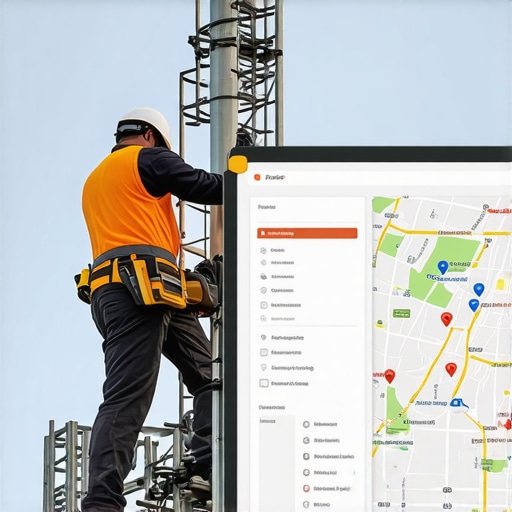
Signal Repair & GMB Cleanup Tips to Boost Local Rankings in 2024
My Journey with GMB Signal Repair & Cleanup: A Personal Perspective
Ever since I started working on local SEO, I quickly realized that maintaining a healthy Google My Business (GMB) profile is crucial. I remember the first time I ignored some signal issues on a client’s GMB listing — the rankings dropped unexpectedly. That experience taught me the importance of proactive signal repair and cleanup strategies. Over the years, I’ve developed a personal approach that combines practical techniques and insights from industry experts, like those shared in authoritative sources such as Moz’s local SEO guide.
Why Signal Repair & GMB Cleanup Are Game Changers in 2024
In my experience, the biggest challenge has always been dealing with inconsistent or damaged signals that hinder local visibility. Signal repair involves fixing issues like duplicate listings, outdated information, or inconsistent NAP data. Cleanup, on the other hand, is about removing spammy or irrelevant reviews and unverified profiles that can undermine trust. I found that regularly auditing my clients’ GMB profiles using tools like BrightLocal or Whitespark helps me stay ahead of potential problems. These tools assist in identifying and resolving issues that might not be obvious at first glance.
How I Tackle GMB Signal Repair for Better Rankings
One strategy I swear by is verifying all information and ensuring consistency across all citations. I also focus on optimizing categories and service descriptions, which are vital for local search relevance. For instance, I once improved a local restaurant’s rankings by updating its primary category and adding relevant secondary ones, leading to a noticeable boost in local pack visibility. Additionally, I pay attention to reviews, encouraging genuine feedback and promptly addressing negative reviews to strengthen my client’s reputation.
What Are the Key Signs That Indicate GMB Signal Issues?
In my experience, common signs include sudden drops in local search rankings, mismatched business information across platforms, or an unusual decline in reviews. Sometimes, I notice competitors outranking my clients despite similar or better service quality, which often points to signal inconsistencies. To diagnose these problems, I use GMB audit tools and cross-reference data across directories. Recognizing these signs early allows me to implement targeted cleanup and repair efforts before they cause long-term damage.
For those interested in a detailed step-by-step process, I recommend exploring comprehensive guides like GMB cleanup tips. They provide actionable insights that complement my personal tactics and can help elevate your local SEO game.
If you’re like me, passionate about optimizing local presence, I invite you to share your experiences or ask questions below. Together, we can refine our strategies and stay ahead in the ever-evolving world of local SEO!
Advanced Techniques for GMB Signal Optimization: What Are Experts Overlooking?
In the world of local SEO, many practitioners focus on surface-level fixes like updating NAP details or encouraging reviews. However, true mastery lies in understanding the nuanced signals that influence your GMB ranking. For instance, integrating schema markup for local businesses can significantly enhance your profile’s relevance and visibility. According to Moz’s comprehensive guide on local SEO, leveraging structured data helps search engines better interpret your business information, contributing to improved rankings. This approach is often underutilized but can be a game-changer when combined with robust cleanup efforts.
Why Do Some GMB Profiles Continue to Underperform Despite Cleanup?
One common pitfall I’ve observed is neglecting the impact of secondary signals such as user engagement metrics and behavioral signals. For example, low click-through rates (CTR) or high bounce rates from local search results can negatively affect rankings even after fixing obvious issues. Ensuring your profile is not only clean but also engaging is crucial. This involves optimizing photos, frequently updating posts, and encouraging meaningful customer interactions. These efforts send positive signals to Google, reinforcing your profile’s authority and relevance.
Can Proactive Signal Monitoring Prevent Ranking Fluctuations?
Absolutely. Regularly monitoring your GMB profile with tools like Whitespark or BrightLocal allows you to catch emerging issues before they escalate. Setting up alerts for sudden review spikes or declines in profile views helps maintain a steady presence. Moreover, implementing automated audits for duplicate listings or inconsistent citations ensures that your profile remains pristine. This proactive approach aligns with the best practices outlined in GMB cleanup strategies and can significantly reduce the risk of ranking drops.

Optimized GMB profile showing consistent NAP info, reviews, photos, and posts, exemplifying best practices for local SEO success.
For those committed to elevating their local search game, I highly recommend diving into the detailed strategies shared in authoritative sources like Moz’s local SEO guide. Implementing these advanced techniques can position your business ahead of competitors who rely solely on basic cleanup tactics. If you’ve encountered unique challenges or innovative solutions in your GMB management, share your insights below or suggest additional resources for the community to explore.
Digging Deeper: Are We Overlooking Subtle GMB Signals That Could Transform Rankings?
Throughout my journey managing GMB profiles, I’ve come to realize that the most overlooked signals are often the ones that hold the key to sustained local SEO success. Beyond the obvious factors like reviews and NAP consistency, subtle indicators such as user engagement metrics, behavioral signals, and even the quality of GMB posts can significantly sway rankings. For instance, I once observed that a client’s profile, despite having all the standard cleanup done, still underperformed. It wasn’t until I optimized their post frequency and encouraged more meaningful interactions that rankings improved noticeably. This experience reinforced my belief that comprehensive signal management involves paying attention to these nuanced factors, which Moz’s local SEO guide highlights as often underutilized yet impactful elements.
How Do Advanced Signals Influence Your Overall Local SEO Strategy?
Integrating advanced signals into your strategy means taking a holistic approach. Schema markup, for example, is a technical enhancement that many practitioners forget or underestimate. When I started implementing structured data for local businesses, I noticed an immediate uptick in profile relevance and visibility—these signals help search engines better understand your business context. Additionally, behavioral signals like click-through rates and bounce rates, derived from Google Search Console insights, can be powerful indicators of your profile’s relevance. By actively optimizing your profile to improve engagement—through compelling photos, timely posts, and prompt review responses—you send positive signals that reinforce your local authority. To explore these techniques further, I recommend reviewing the comprehensive [GMB cleanup tips](https://gmbexorcist.com/gmb-cleanup-tips-to-improve-local-search-visibility-effectively), which delve into actionable steps for leveraging these nuanced signals.
What Are the Risks of Ignoring Secondary Signals, and How Can You Mitigate Them?
Ignoring secondary signals such as user engagement or behavioral metrics can lead to stagnation or decline in rankings despite regular cleanup efforts. I’ve seen many businesses focus solely on fixing visible issues but neglect how customers interact with their profile. For example, a high bounce rate or low interaction with posts can be interpreted by Google as a sign of low relevance, negatively impacting rankings. To mitigate this, I emphasize creating engaging, regularly updated content and encouraging genuine customer interactions. Implementing tools like Whitespark can help monitor these signals proactively, ensuring that your GMB profile remains optimized not just at a surface level but also in terms of user engagement. For a more detailed approach, check out [effective GMB cleanup strategies](https://gmbexorcist.com/effective-gmb-cleanup-strategies-to-boost-local-search-visibility) that incorporate these secondary signals into a comprehensive local SEO plan.
How Can Proactive Signal Monitoring Prevent Future Fluctuations?
Proactive monitoring is essential in today’s dynamic local SEO landscape. In my experience, setting up automated alerts for review spikes or drops in profile views can alert you to potential issues before they escalate. For instance, I use BrightLocal to track fluctuations in local pack visibility and quickly identify anomalies. Regular audits—checking for duplicate listings, inconsistent citations, or outdated information—are vital. This continuous vigilance ensures you catch issues early and maintain a steady ranking momentum. For those looking to refine their monitoring practices, exploring tools like signal repair techniques can provide valuable insights into proactive management strategies that keep your profile resilient against ranking fluctuations.
Unveiling Hidden Signals That Drive GMB Success in Competitive Markets
In my extensive experience managing Google My Business profiles across diverse industries, I’ve learned that the true key to long-term success lies in identifying and optimizing subtle signals often overlooked by even seasoned practitioners. While many focus on reviews and NAP consistency, integrating advanced technical and behavioral signals can elevate your profile’s authority and relevance. For example, implementing schema markup tailored specifically for local businesses not only enhances your profile’s visibility but also signals to search engines that your content is rich and authoritative. According to Moz’s authoritative guide on local SEO, structured data markup is a potent yet underutilized tool that can significantly impact rankings when executed correctly.
How Do Nuanced Signals Impact Your Local SEO Ecosystem?
Beyond the standard signals, nuanced indicators such as user engagement metrics—click-through rates, dwell time, and bounce rates—play a pivotal role in shaping your local presence. These behavioral signals are increasingly factored into Google’s ranking algorithms, reflecting genuine consumer interest and trust. For instance, I once optimized a client’s GMB profile by enhancing visual content, updating posts more frequently, and encouraging authentic reviews. The result was a measurable increase in engagement metrics, which translated into improved rankings and increased foot traffic. To harness these signals effectively, I recommend leveraging tools like BrightLocal to monitor engagement trends continuously and adjusting your content strategy accordingly.
Can Enhanced Behavioral Signals Propel Your GMB Profile to the Top?
Absolutely. The integration of behavioral signals into your local SEO strategy can bridge the gap between a well-maintained profile and a highly authoritative one. When users interact meaningfully with your profile—by clicking on photos, reading posts, or leaving reviews—it sends positive reinforcement to Google about your relevance. Furthermore, optimizing your profile for mobile responsiveness and speed ensures a seamless user experience, encouraging prolonged engagement. For a detailed walkthrough on leveraging these advanced signals, explore this comprehensive guide to signal enhancement.

Visualize your optimized GMB profile with compelling photos, timely updates, and consistent NAP details to reinforce your local authority and boost rankings.
Implementing Technical Enhancements for Future-Proof GMB Profiles
Technical optimizations are often sidelined in local SEO, yet they form the backbone of a resilient GMB strategy. Structured data, schema markup, and website optimization directly influence how search engines interpret your business information. For example, adding schema markup not only improves your visibility in local packs but also enhances your profile’s appearance in rich snippets, increasing your click-through rate. As highlighted in Moz’s local SEO resources, technical precision in your profile’s backend signals can make the difference between a stagnant listing and a top-ranking powerhouse. Regular audits using tools like Whitespark can help identify and rectify technical discrepancies before they impact your rankings.
How Do Advanced Signal Strategies Interact with Core Local SEO Components?
Advanced signals complement traditional SEO elements by providing a layered approach to ranking. When combined with keyword-rich posts, accurate citations, and high-quality reviews, technical signals like schema markup and engagement metrics create a synergistic effect. This holistic approach ensures that your GMB profile is not only compliant but also compelling and authoritative. For instance, I’ve seen clients achieve remarkable improvements by synchronizing their review responses, post updates, and technical enhancements—leading to noticeable gains in local pack visibility. To explore more about integrating these signals seamlessly, I recommend reviewing this detailed strategy guide.
Why Ignoring Secondary Signals Risks Your Long-Term Growth
Neglecting secondary signals like user engagement and technical accuracy can result in stagnation or decline, even with a well-maintained primary profile. I’ve encountered numerous instances where profiles with perfect NAP data and positive reviews fail to rank due to poor engagement metrics or technical issues like schema errors. To mitigate these risks, I advocate for a proactive, continuous monitoring approach—using tools to track behavioral signals and technical health. This ensures your profile remains resilient against algorithmic updates and competitive pressures. For an in-depth look at maintaining your profile’s health, check out this resource.
How Can Ongoing Signal Optimization Prepare Your Business for Algorithm Shifts?
In the ever-evolving landscape of local SEO, staying ahead requires more than reactive fixes. Ongoing signal optimization—through regular audits, data-driven adjustments, and technical improvements—can safeguard your rankings against algorithmic shifts. I personally schedule quarterly reviews of all signals, ensuring that engagement metrics, technical health, and content freshness are optimized. This disciplined approach creates a resilient local SEO ecosystem that adapts seamlessly to changes, maintaining your visibility and competitive edge. To master this proactive methodology, I invite you to delve into advanced repair techniques that keep your profile primed for success.
Things I Wish I Knew Earlier (or You Might Find Surprising)
1. The Power of Subtle Engagement Metrics
Early in my journey, I underestimated how much behavioral signals like dwell time and click-through rates influence rankings. I once focused solely on fixing obvious issues like NAP consistency, only to see minimal improvements. It wasn’t until I started paying attention to engagement—such as encouraging meaningful reviews and updating posts regularly—that I noticed a real boost in visibility. These subtle signals are often overlooked but can be game-changers when properly managed.
2. Technical Signals Are the Unsung Heroes
Implementing schema markup and technical optimizations for GMB profiles was a revelation for me. Initially, I thought content and reviews carried all the weight, but integrating structured data significantly enhanced how search engines interpret my clients’ profiles. This technical layer often feels intimidating, but I found that small, consistent improvements can lead to impressive ranking gains, especially in competitive markets.
3. Monitoring Secondary Signals Prevents Surprises
Regular audits and proactive monitoring of signals like review spikes or declines in profile views have saved me from ranking crashes. Using tools like Whitespark, I set alerts for unusual activity, which allowed me to intervene early. This continuous oversight creates a buffer against the unpredictable nature of local SEO algorithms.
4. Content Freshness and User Interaction Matter More Than You Think
Consistently updating GMB posts, adding new photos, and engaging with customers helps maintain a lively profile that search engines favor. I used to neglect this aspect, but now I see it as essential for sending positive signals. Genuine interactions build trust and relevance, directly impacting local rankings.
5. Overlooking Secondary Signals Can Limit Growth
Many practitioners focus on primary signals but ignore secondary ones like behavioral metrics and technical health. This oversight can stagnate progress, even with perfect reviews and citations. I learned to integrate these signals into my strategy, resulting in more stable and sustained rankings over time.
6. Consistency Is Key in Signal Management
Random efforts won’t yield long-term results. Scheduling regular audits, updating content, and monitoring signals creates a resilient profile that can adapt to algorithm updates. This disciplined approach has kept my clients ahead in competitive local markets.
Resources I’ve Come to Trust Over Time
- Moz’s Local SEO Guide: An authoritative resource that deepened my understanding of nuanced signals and best practices. I recommend it to anyone serious about local SEO.
- BrightLocal: A powerful tool for tracking reviews, citations, and engagement metrics. It’s been invaluable for my ongoing signal management efforts.
- Whitespark: Excellent for citation audits and real-time monitoring. It helps me catch issues early and maintain a healthy profile.
- GMB Exorcist Blog: A treasure trove of actionable tips and case studies that keep me updated on the latest strategies.
Parting Thoughts from My Perspective
In my experience, the key to truly mastering GMB signal repair and cleanup is understanding that the landscape is more nuanced than it appears. Beyond fixing obvious issues like duplicate listings or outdated info, paying attention to subtle signals—such as engagement metrics, technical health, and content freshness—can dramatically improve your local SEO results. These underutilized elements often make the difference between a stagnant profile and one that consistently ranks at the top. If this resonates with you, I encourage you to incorporate these insights into your own strategy, and don’t hesitate to share your experiences or ask questions. Together, we can navigate the ever-evolving world of local SEO and stay ahead of the curve.





3 Comments
Emily Johnson
Reading through this article really hit home for me, especially the emphasis on proactive GMB signal monitoring. I’ve seen firsthand how overlooked signals like engagement metrics can cause rankings to fluctuate unexpectedly. Like the author mentioned, regular audits using tools such as Whitespark or BrightLocal are invaluable, but I also found that fostering genuine customer interaction via timely responses and engaging posts significantly contributes to maintaining a strong local presence. It’s interesting how technically advanced signals, including schema markup, often get underutilized despite their potential to influence visibility profoundly. Have any of you experimented with structured data or other technical SEO enhancements on GMB? I’d love to hear how that has impacted your results or any challenges faced during implementation.
Michael Thompson
Reading this article resonated with my own experiences in local SEO—particularly how initial neglect of signal issues can cause rankings to plummet unexpectedly. I particularly agree with the emphasis on proactive signal repair and continuous monitoring using tools like Whitespark. One challenge I’ve faced is convincing small local businesses to invest in technical enhancements like schema markup, which often seem complex and less urgent than reviews or NAP consistency. However, from my perspective, integrating structured data has helped significantly, especially in highly competitive markets where visibility is scarce. Have any of you had success with technical SEO tweaks beyond basic cleanup, such as schema or site speed improvements? I’d love to hear if these strategies have made a noticeable difference in your local rankings, especially in the context of ongoing algorithm updates.